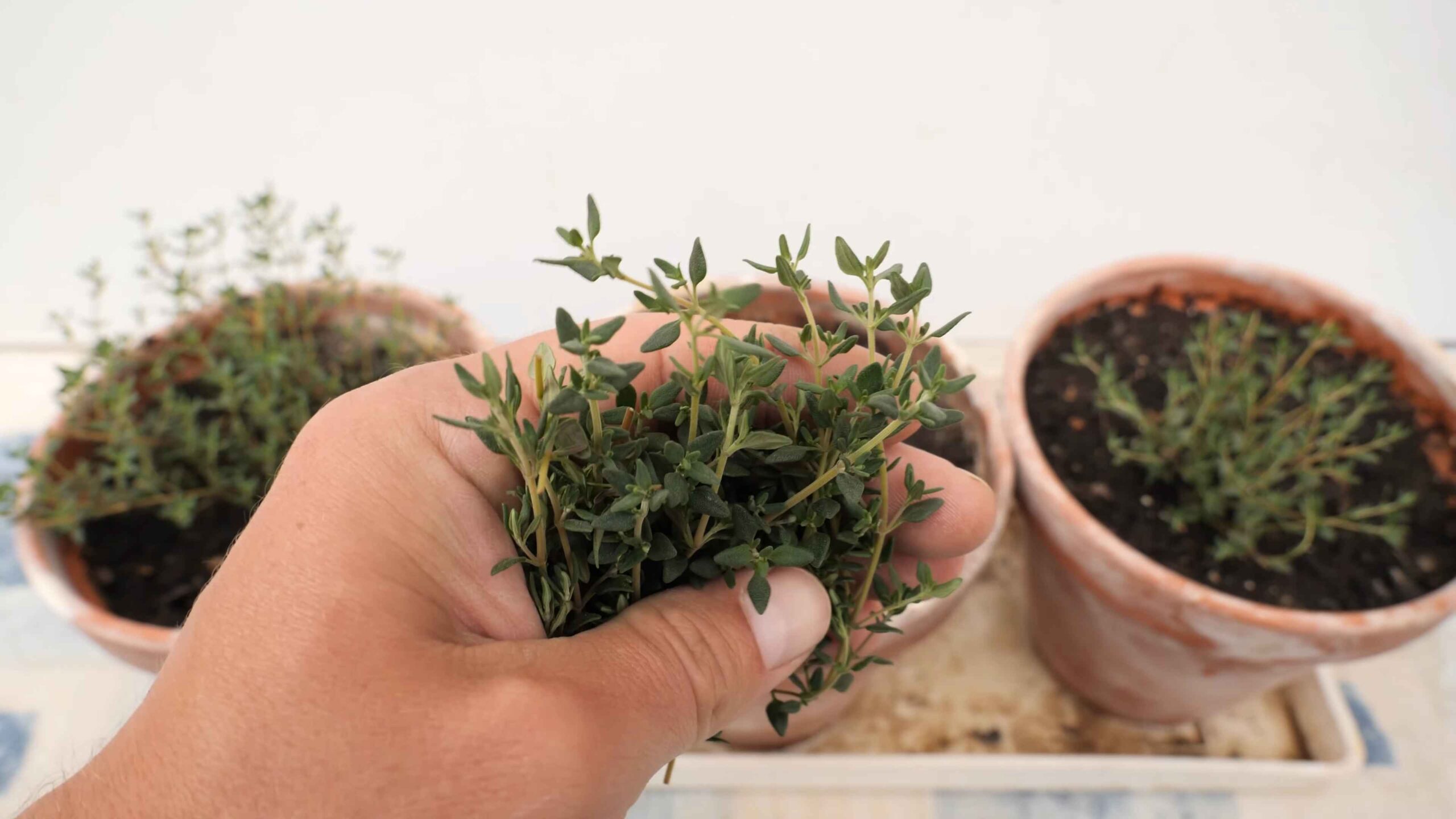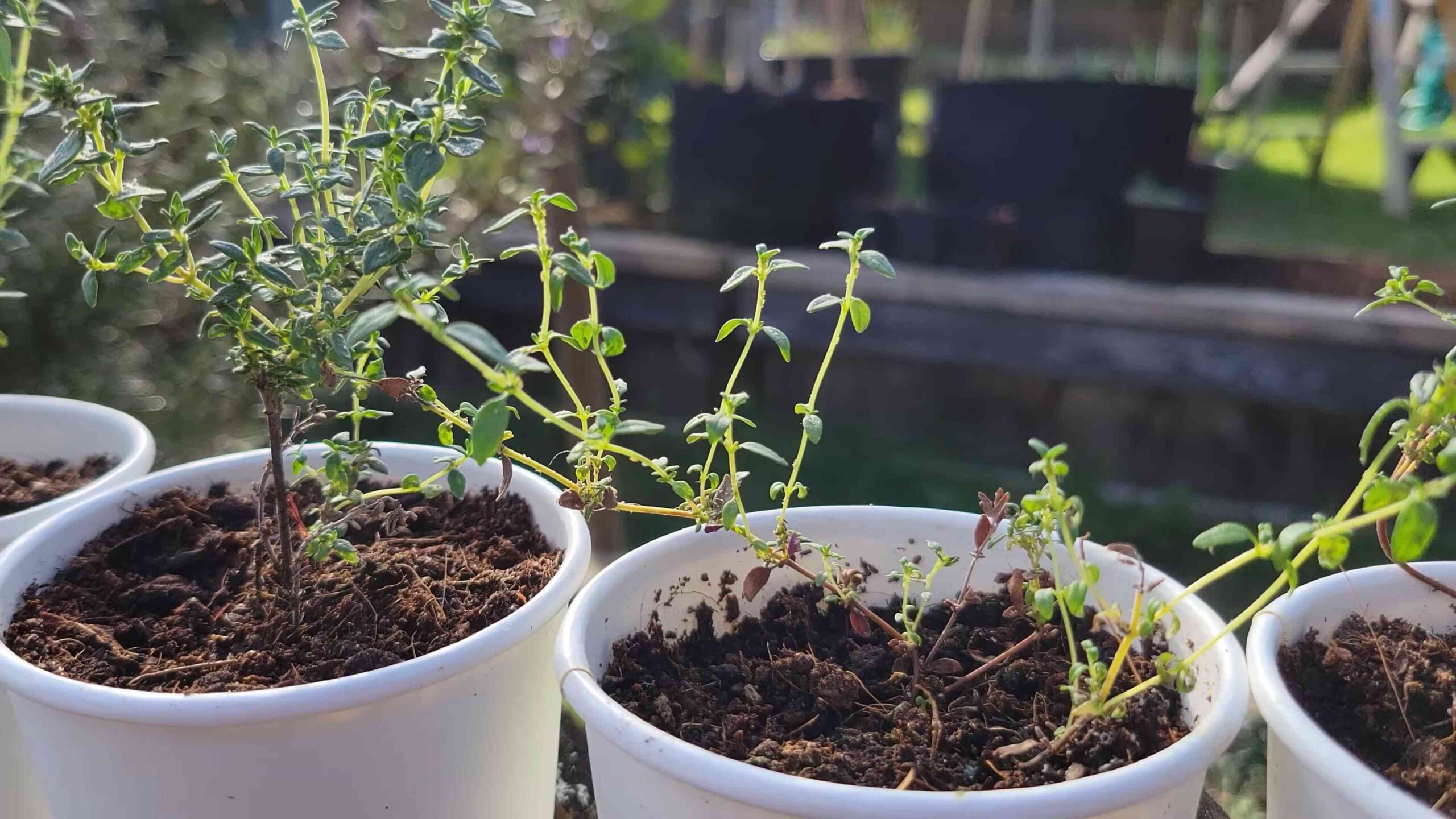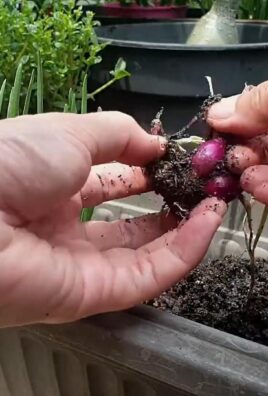Grow Thyme Indoors? Absolutely! Imagine stepping into your kitchen and snipping fresh, fragrant thyme to elevate your culinary creations. No more last-minute grocery store runs or settling for dried herbs that lack that vibrant zest. This isn’t just a dream; it’s an achievable reality with a few simple DIY tricks.
Thyme, with its rich history dating back to ancient Egypt where it was used for embalming, and its symbolic association with courage in ancient Greece, has always been a valued herb. Today, its culinary and medicinal properties continue to be celebrated. But let’s face it, not everyone has the space or climate for a sprawling outdoor herb garden. That’s where the magic of indoor gardening comes in!
I’m here to show you how easy and rewarding it can be to grow thyme indoors, regardless of your experience level. Whether you’re a seasoned gardener or a complete beginner, these DIY hacks will empower you to cultivate a thriving thyme plant right on your windowsill. We’ll cover everything from choosing the right container and soil to providing optimal light and watering techniques. Get ready to unlock the secrets to a constant supply of fresh thyme, adding a touch of flavor and fragrance to your home all year round!

Growing Thyme Indoors: A Beginner’s Guide
Hey there, fellow plant enthusiasts! Ever dreamt of having fresh, fragrant thyme right at your fingertips, no matter the season? Well, you’re in luck! Growing thyme indoors is surprisingly easy and rewarding. I’m going to walk you through everything you need to know to cultivate your own little thyme haven inside your home. Let’s get started!
Choosing the Right Thyme Variety
First things first, let’s talk thyme varieties. While most thyme will grow indoors, some are better suited than others. Here are a few of my favorites:
* **English Thyme (Thymus vulgaris):** This is your classic, all-purpose thyme. It’s got a strong, earthy flavor and is perfect for cooking. Plus, it’s relatively compact, making it ideal for indoor containers.
* **Lemon Thyme (Thymus citriodorus):** If you’re looking for a bit of a citrusy twist, lemon thyme is the way to go. Its bright, lemony aroma and flavor are fantastic in teas, salads, and even desserts.
* **Creeping Thyme (Thymus serpyllum):** While often used as a ground cover outdoors, creeping thyme can also thrive indoors, especially in hanging baskets or containers where it can cascade over the edges. It has a slightly milder flavor than English thyme.
Gathering Your Supplies
Okay, now that we’ve picked our thyme, let’s gather our supplies. You’ll need:
* **Thyme Seeds or a Thyme Plant:** You can start from seeds, but buying a small established plant from a nursery or garden center will give you a head start.
* **A Pot with Drainage Holes:** Drainage is crucial! Thyme hates soggy roots. Choose a pot that’s at least 6 inches in diameter. Terracotta pots are great because they allow the soil to breathe.
* **Well-Draining Potting Mix:** Regular garden soil is too heavy for containers. Use a potting mix specifically formulated for herbs or vegetables. You can even make your own by mixing equal parts potting soil, perlite, and compost.
* **Grow Lights (Optional but Recommended):** Thyme needs plenty of sunlight, and if you don’t have a sunny windowsill, grow lights will be your best friend.
* **Watering Can or Spray Bottle:** For gentle watering.
* **Scissors or Pruning Shears:** For harvesting and pruning.
* **Fertilizer (Optional):** A balanced liquid fertilizer can help boost growth, but it’s not essential.
Planting Your Thyme
Alright, let’s get our hands dirty! Here’s how to plant your thyme:
1. **Prepare the Pot:** Fill your pot with the well-draining potting mix, leaving about an inch of space at the top.
2. **Planting from Seeds:** If you’re starting from seeds, sprinkle them evenly over the surface of the soil. Gently press them down, but don’t bury them too deep. Cover them with a very thin layer of soil. Water gently with a spray bottle to avoid disturbing the seeds.
3. **Planting a Thyme Plant:** If you’re using a plant, gently remove it from its nursery container. Loosen the roots a bit with your fingers. Dig a hole in the center of the pot that’s large enough to accommodate the root ball. Place the plant in the hole and fill in around it with potting mix. Gently press down the soil to secure the plant.
4. **Water Thoroughly:** Water the thyme thoroughly after planting, until water drains out of the drainage holes.
Caring for Your Indoor Thyme
Now comes the fun part – nurturing your thyme and watching it thrive! Here’s what you need to do:
1. **Sunlight:** Thyme needs at least 6-8 hours of sunlight per day. Place your pot on a sunny windowsill that faces south or west. If you don’t have enough natural light, use grow lights. Position the lights a few inches above the plant and keep them on for 12-14 hours a day.
2. **Watering:** Thyme is drought-tolerant, so don’t overwater it! Let the soil dry out almost completely between waterings. When you do water, water deeply until water drains out of the drainage holes. Avoid getting the leaves wet, as this can lead to fungal diseases. I usually check the soil moisture by sticking my finger about an inch into the soil. If it feels dry, it’s time to water.
3. **Temperature:** Thyme prefers temperatures between 60-70°F (15-21°C). Avoid placing it near drafts or heat sources.
4. **Humidity:** Thyme doesn’t need high humidity. In fact, too much humidity can be detrimental. If your home is very humid, make sure there’s good air circulation around the plant.
5. **Fertilizing:** You can fertilize your thyme every few weeks during the growing season (spring and summer) with a balanced liquid fertilizer diluted to half strength. However, be careful not to over-fertilize, as this can make the thyme leggy and less flavorful. I usually skip fertilizing altogether and just rely on the nutrients in the potting mix.
6. **Pruning:** Pruning is essential for keeping your thyme plant healthy and productive. Regularly pinch back the tips of the stems to encourage bushier growth. You can also prune away any dead or yellowing leaves.
7. **Repotting:** You’ll need to repot your thyme plant every year or two as it outgrows its pot. Choose a pot that’s slightly larger than the current one and use fresh potting mix.
Harvesting Your Thyme
The best part about growing your own thyme is, of course, harvesting it! You can start harvesting thyme once the plant is about 6 inches tall.
1. **Harvesting:** Use scissors or pruning shears to snip off stems as needed. Cut the stems just above a leaf node (the point where leaves grow from the stem). This will encourage new growth.
2. **Drying Thyme:** If you want to dry your thyme for later use, tie the stems together in small bundles and hang them upside down in a cool, dry, and well-ventilated place. Once the leaves are completely dry, crumble them and store them in an airtight container. You can also dry thyme in a dehydrator or oven on low heat.
Troubleshooting Common Problems
Even with the best care, you might encounter some problems with your indoor thyme. Here are a few common issues and how to deal with them:
* **Yellowing Leaves:** This could be a sign of overwatering, underwatering, or nutrient deficiency. Check the soil moisture and adjust your watering accordingly. If the soil is dry, water thoroughly. If it’s soggy, let it dry out completely before watering again. If the problem persists, try fertilizing with a balanced liquid fertilizer.
* **Leggy Growth:** This is usually caused by insufficient sunlight. Move your thyme to a sunnier location or use grow lights.
* **Pests:** Thyme is relatively pest-resistant, but it can occasionally be affected by aphids or spider mites. If you see any pests, try spraying the plant with insecticidal soap.
* **Root Rot:** This is caused by overwatering and poor drainage. Make sure your pot has drainage holes and that you’re not overwatering. If you suspect root rot, repot the thyme in fresh potting mix.
Enjoying Your Homegrown Thyme
Now that you’ve successfully grown your own thyme indoors, it’s time to enjoy the fruits (or rather, herbs!) of your labor. Use your fresh thyme to flavor soups, stews, sauces, roasted vegetables, meats, and more. You can also use it to make herbal teas or infuse oils and vinegars. The possibilities are endless!
Growing thyme indoors is a rewarding experience that will add a touch of freshness and flavor to your life. With a little care and attention, you can enjoy a continuous supply of this versatile herb all year round. Happy growing!

Conclusion
So, there you have it! Growing thyme indoors is not only achievable, but it’s also incredibly rewarding. Imagine having fresh, fragrant thyme readily available to elevate your culinary creations, no matter the season. Forget those sad, dried-out jars of herbs in the spice rack – with a little effort, you can cultivate your own thriving thyme plant right on your windowsill.
This DIY trick is a must-try for several reasons. First, it’s cost-effective. Purchasing fresh thyme from the grocery store regularly can add up, especially if you use it frequently. Starting your own plant is a one-time investment that will yield a continuous supply of this versatile herb. Second, it’s incredibly convenient. No more last-minute trips to the store when you realize you’re out of thyme for your favorite recipe. Third, it’s environmentally friendly. You’re reducing your reliance on commercially grown herbs that may have traveled long distances, contributing to a smaller carbon footprint.
But the best reason to try growing thyme indoors is the sheer satisfaction of nurturing a plant and watching it flourish. There’s something deeply fulfilling about harvesting your own herbs and using them to create delicious meals. Plus, the aroma of fresh thyme wafting through your home is an added bonus!
Don’t be afraid to experiment with different varieties of thyme. Lemon thyme adds a bright, citrusy note to dishes, while creeping thyme is perfect for ground cover (though it can also be grown indoors in a hanging basket). You can also try propagating thyme from cuttings, which is a great way to expand your herb garden without spending any money. Consider using different types of containers, from terracotta pots to repurposed jars, to add a touch of personality to your indoor garden.
We encourage you to give this DIY trick a try. It’s easier than you might think, and the rewards are well worth the effort. Once you’ve successfully grown your own thyme indoors, we’d love to hear about your experience! Share your tips, tricks, and photos in the comments below. Let’s create a community of indoor herb gardeners and inspire others to embrace the joy of growing their own food. Remember, even a small pot of thyme can make a big difference in your kitchen and your life. So, grab a pot, some soil, and a thyme plant, and get growing! You’ll be amazed at how easy it is to bring a little bit of nature indoors and enjoy the fresh, flavorful benefits of homegrown thyme.
FAQ
What kind of thyme should I grow indoors?
The best types of thyme to grow indoors are those that stay relatively compact and are well-suited to container gardening. Common thyme (Thymus vulgaris) is a great choice, as it’s readily available and has a classic thyme flavor. Lemon thyme (Thymus citriodorus) is another popular option, offering a delightful citrusy aroma and flavor. Creeping thyme (Thymus serpyllum) can also be grown indoors, especially in hanging baskets, although it may require more frequent trimming to keep it from becoming too sprawling. Ultimately, the best type of thyme for you will depend on your personal preferences and the space you have available.
How much sunlight does indoor thyme need?
Thyme thrives in bright, sunny conditions. Ideally, your indoor thyme plant should receive at least six hours of direct sunlight per day. A south-facing window is usually the best option, but an east- or west-facing window can also work if it provides sufficient light. If you don’t have access to a sunny window, you can supplement with a grow light. Position the grow light a few inches above the plant and leave it on for 12-14 hours per day. Insufficient sunlight can lead to leggy growth and a less flavorful herb.
What kind of soil is best for growing thyme indoors?
Thyme prefers well-draining soil that is slightly alkaline. A good potting mix for thyme should be light and airy, allowing for good root aeration. You can create your own potting mix by combining equal parts of potting soil, perlite, and sand. Avoid using heavy, clay-based soils, as these can retain too much moisture and lead to root rot. Adding a small amount of lime to the soil can help to increase its alkalinity.
How often should I water my indoor thyme plant?
Thyme is relatively drought-tolerant and does not like to be overwatered. Allow the soil to dry out completely between waterings. When you do water, water thoroughly until the water drains out of the bottom of the pot. Avoid getting the foliage wet, as this can promote fungal diseases. During the winter months, when the plant is not actively growing, you may need to water even less frequently.
How do I harvest thyme from my indoor plant?
You can begin harvesting thyme once the plant is established and has several stems. To harvest, simply snip off the stems with a pair of scissors or pruning shears. Avoid removing more than one-third of the plant at a time, as this can stress the plant. The best time to harvest thyme is in the morning, after the dew has dried. Freshly harvested thyme can be used immediately or dried for later use.
How do I dry thyme from my indoor plant?
There are several ways to dry thyme. One method is to tie the stems together in small bundles and hang them upside down in a cool, dry, and well-ventilated place. Another method is to spread the thyme leaves on a baking sheet and dry them in a low oven (around 170°F) for a few hours. You can also use a dehydrator to dry thyme. Once the thyme is completely dry, store it in an airtight container in a cool, dark place.
How do I propagate thyme from cuttings?
Propagating thyme from cuttings is a simple and effective way to create new plants. To take a cutting, snip off a 4-6 inch stem from a healthy thyme plant. Remove the leaves from the bottom inch of the stem. Dip the cut end of the stem in rooting hormone (optional). Plant the cutting in a small pot filled with well-draining potting mix. Water the cutting and cover it with a plastic bag or humidity dome to create a humid environment. Place the cutting in a bright, indirect light location. After a few weeks, the cutting should develop roots. Once the roots are established, you can transplant the cutting into a larger pot.
Why is my indoor thyme plant turning yellow?
Yellowing leaves on your indoor thyme plant can be caused by several factors, including overwatering, underwatering, nutrient deficiencies, and pests. Check the soil moisture to determine if you are watering too much or too little. If the soil is consistently wet, reduce your watering frequency. If the soil is bone dry, water more thoroughly. You can also try fertilizing your thyme plant with a balanced liquid fertilizer to address any nutrient deficiencies. Inspect the plant for pests, such as aphids or spider mites, and treat accordingly.
My thyme plant is leggy and not producing much foliage. What should I do?
Leggy growth in thyme is often a sign of insufficient sunlight. Move your plant to a sunnier location or supplement with a grow light. You can also prune the plant back to encourage bushier growth. Use a pair of scissors or pruning shears to trim the stems back by about one-third. This will encourage the plant to produce new growth and become more compact.
How often should I fertilize my indoor thyme plant?
Thyme is not a heavy feeder and does not require frequent fertilization. Fertilize your thyme plant every 2-3 months during the growing season (spring and summer) with a balanced liquid fertilizer diluted to half strength. Avoid fertilizing during the winter months, when the plant is not actively growing. Over-fertilizing can lead to leggy growth and a less flavorful herb.





Leave a Comment